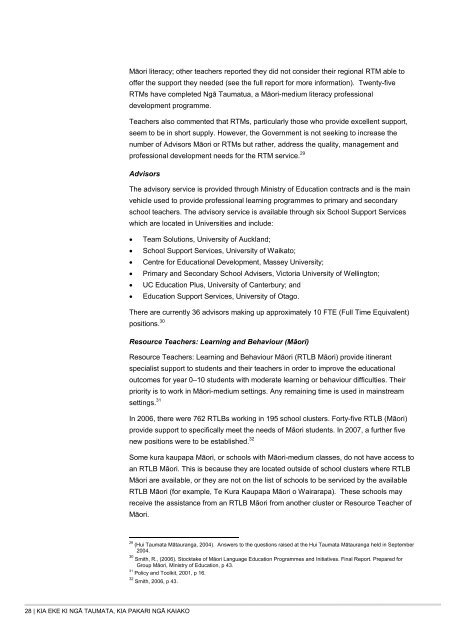Kia eke ki ngÄ Taumata, kia Pakari ngÄ Kaiako He ... - Te Puni Kokiri
Kia eke ki ngÄ Taumata, kia Pakari ngÄ Kaiako He ... - Te Puni Kokiri
Kia eke ki ngÄ Taumata, kia Pakari ngÄ Kaiako He ... - Te Puni Kokiri
You also want an ePaper? Increase the reach of your titles
YUMPU automatically turns print PDFs into web optimized ePapers that Google loves.
Māori literacy; other teachers reported they did not consider their regional RTM able tooffer the support they needed (see the full report for more information). Twenty-fiveRTMs have completed Ngā Taumatua, a Māori-medium literacy professionaldevelopment programme.<strong>Te</strong>achers also commented that RTMs, particularly those who provide excellent support,seem to be in short supply. However, the Government is not see<strong>ki</strong>ng to increase thenumber of Advisors Māori or RTMs but rather, address the quality, management andprofessional development needs for the RTM service. 29AdvisorsThe advisory service is provided through Ministry of Education contracts and is the mainvehicle used to provide professional learning programmes to primary and secondaryschool teachers. The advisory service is available through six School Support Serviceswhich are located in Universities and include:• <strong>Te</strong>am Solutions, University of Auckland;• School Support Services, University of Waikato;• Centre for Educational Development, Massey University;• Primary and Secondary School Advisers, Victoria University of Wellington;• UC Education Plus, University of Canterbury; and• Education Support Services, University of Otago.There are currently 36 advisors ma<strong>ki</strong>ng up approximately 10 FTE (Full Time Equivalent)positions. 30Resource <strong>Te</strong>achers: Learning and Behaviour (Māori)Resource <strong>Te</strong>achers: Learning and Behaviour Māori (RTLB Māori) provide itinerantspecialist support to students and their teachers in order to improve the educationaloutcomes for year 0–10 students with moderate learning or behaviour difficulties. Theirpriority is to work in Māori-medium settings. Any remaining time is used in mainstreamsettings. 31In 2006, there were 762 RTLBs wor<strong>ki</strong>ng in 195 school clusters. Forty-five RTLB (Māori)provide support to specifically meet the needs of Māori students. In 2007, a further fivenew positions were to be established. 32Some kura kaupapa Māori, or schools with Māori-medium classes, do not have access toan RTLB Māori. This is because they are located outside of school clusters where RTLBMāori are available, or they are not on the list of schools to be serviced by the availableRTLB Māori (for example, <strong>Te</strong> Kura Kaupapa Māori o Wairarapa). These schools mayreceive the assistance from an RTLB Māori from another cluster or Resource <strong>Te</strong>acher ofMāori.29 (Hui <strong>Taumata</strong> Mātauranga, 2004). Answers to the questions raised at the Hui <strong>Taumata</strong> Mātauranga held in September2004.30 Smith, R., (2006). Stocktake of Māori Language Education Programmes and Initiatives. Final Report. Prepared forGroup Māori, Ministry of Education, p 43.31 Policy and Tool<strong>ki</strong>t, 2001, p 16.32 Smith, 2006, p 43.28 | KIA EKE KI NGĀ TAUMATA, KIA PAKARI NGĀ KAIAKO
















